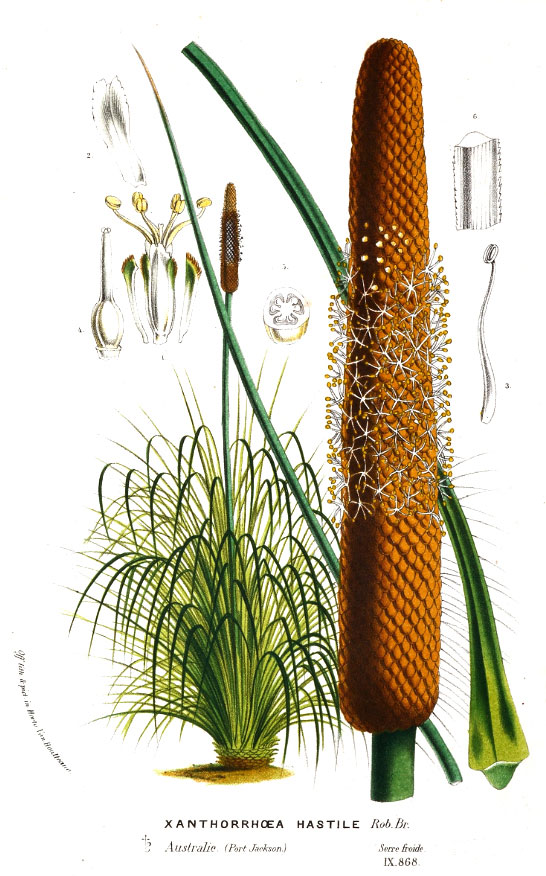Balga (Grass Tree)

Origin: Australia
Family: Asphodelaceae
Scientific Name: Xanthorrhoea preissii Endl.
Indigenous Names: Balga (Noongar), yakka (SA, possibly Kaurna)
Folk Names: Previously known as “blackboys” due to the flowering plant being seen as resembling an Indigenous person with a spear. Now known primarily as Grass Trees.
Ethical Concerns: The name “blackboy” is no longer at the request of the Indigenous community, due to the racist/colonialist background.
Magical
Element: Air
Direction: North
Day: Wednesday
Planet: Uranus
Zodiac: Aquarius
Parts Used: Leaves, resin
Magical Properties: Longevity, travel, knowledge, resilience, strength, sincerity
Magical Uses
- Use the resin as a base for incense blends
- The leaves would be excellent for making a besom
Medicinal
Indigenous Medicinal Uses:
- The pulp from the inside of the top of the tree was eaten to help upset stomachs
- The gum was chewed to relieve both diarrhoea and constipation
- The smoke from burning the resin was inhaled to help relieve sinusitis
Practical
The resin was frequently used in Australia until the mid-1990s, including being burnt in churches as incense, used for polishing/coating metal surfaces, and as an ingredient in wood varnish.
Indigenous Uses:
- The highly flammable resin was used to start fires
- The resin was combined with charcoal and kangaroo droppings and heated to produce a strong glue
- A solution of balga resin was used to tan animal hides
- The flowers could be soaked in water to produce a sweet drink
- The soft, white material inside the top of the trunk can be squeezed to liquid when drinking water is scarce
- Young leaf shoots are edible, as are the Bardi grubs which tend to live amongst the roots
- Flowers can be used to aid navigation, as they open in the direction of the sun’s path (ie primarily from the north)
- The slower spikes were used as spear shafts, torches (to transport fire), and also to start fires bu friction.
Botanical
Xanthorrhoea contains roughly 30 species, all known as grass trees, which are endemic to Australia and found in all states.
There are records of grass trees over 7m high, although these were mostly cut down by colonisers, and most remaining plants are under 3m tall.
Type: Perennial ‘tree’
Plant size: 3m+
Bark: Fern-like ‘trunk’ of previous years' leaf growth
Leaves: Tough, narrow grass-like leaves with a diamond cross-section, often over 1m long
Flowers: Djilba to
Kambarang: Many small cream-coloured flowers on an upright spike 1.5-2.5m long
Fruit: A small portion of flowers tend to develop into fruits, which form round/pointed woody capsules which open to release seeds.
Etymology: Xanthorrhoea refers to the resin from the plants, and comes from Ancient Greek “yellow flow” - xanthos (‘yellow, golden’) and rhoea (‘flowing, flow’).
In the Garden
Type: Slow-growing perennial
Light: Full sun
Water: Drought-tolerant
Soil: Well-draining
Tips:
- Incredibly slow-growing: Can take 20 years just to form a base and begin growing upwards.
- To encourage the establishment of a new plant, dissolve a cup of brown sugar in a bucket of water, and water with this monthly for the first two years. This will feed the root bacteria that the plant relies on.
References:
Campbell, Colin (25/02/2006), Gardening Australia: from https://www.abc.net.au/gardening/factsheets/grass-tree/9426588
